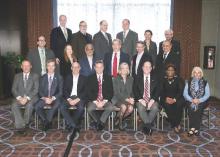Dr. Barbara Phillips, MSPH, FCCP
CHEST President 2015-2016
Nancy MacRae
Senior Vice President, Governance and Operations
Jenny Nemkovich, CAE
Chief Strategy Officer, Executive Office
Ever wonder how decisions get made and work gets done at CHEST? It all starts with our strategic plan (www.chestnet.org/About/Overview/Strategic-Plan), which was developed by the Board of Regents and other key stakeholders. The development of the strategic plan was informed by our vision to be the global leader in advancing best patient outcomes through innovative chest medicine, education, clinical research, and team-based care, as well as our mission and values. As a result of our strategic planning, CHEST is all about clinical education, which is our “hedgehog,” in organization-speak (1), but we also have goals in guideline development, global impact, membership recruitment and retention, and (of course) fiscal health. We follow progress toward our goals with measurable, relevant key performance indicators (KPIs), and the board reviews progress toward KPIs and goals at nearly every meeting, making recommendations for adjustments, as needed.
But how do decisions get made? CHEST volunteer and staff leadership work together to initiate and execute projects consistent with our plan and respond to requests from others to explore collaborative opportunities to advance our goals.
An example of a process that was initiated by leadership was the development of our new membership model. The Community and Engagement Work Group, along with key staff and other stakeholders, reviewed environmental scans, their personal knowledge and situations, and data from surveys of CHEST members, as well as association trends. They then proposed a new membership model to the Board of Regents (BoR). The BoR reviewed the proposal, along with other important information, and expressed concerns about several key constituent groups, such as global members and members in training, along with several other issues. In fact, the BoR sent the proposal back to the Work Group. Twice. As with any new project, the BoR makes a concerted effort to focus on the strategic plan in these types of deliberations and was guided particularly by the strategy to “optimize new membership model to increase engagement of all clinicians on the health-care team.” The final proposal, implemented in May 2015, truly reflects input and concerns from the BoR, key staff, the Membership Committee, and those CHEST members who responded to the surveys.
An example of a request by another organization to sign on, endorse, cosponsor, or otherwise support a guideline or project is the Campaign for Tobacco-Free Kids contacting us asking us to sign on to a letter to all members of the United States Senate and House of Representatives supporting the tobacco control measure included in the Trans-Pacific Partnership (TPP) trade agreement. The provision will protect the rights of nations participating in the TPP to adopt public health measures that reduce tobacco use without fear of facing lengthy and expensive trade disputes under the TPP initiated by tobacco companies.
Our process in these situations is to gather as much input as possible from CHEST members and experts. Again, using our strategic plan as guidance, in this specific instance, we are expanding our global impact, using targeted strategic alliances, so the decision was made to support this initiative. The CHEST name and brand are valuable assets, and we take endorsement of any project or document very seriously.
Key to our organizational success is our outstanding volunteer/staff partnership that fosters teamwork in translating the strategic vision, mission, and goals of the organization, engaging in a deliberative process that considers organizational history, data, trends, and expert opinion – all to help inform leadership in its decision-making. This collaboration between our content experts and our association professionals is a huge asset to our organization and one that will continue to propel CHEST to achieve our goals.
1. Collins J. Good to Great and the Social Sectors: A Monograph to Accompany Good to Great. New York, NY: HarperCollins Publishers; 2005.



